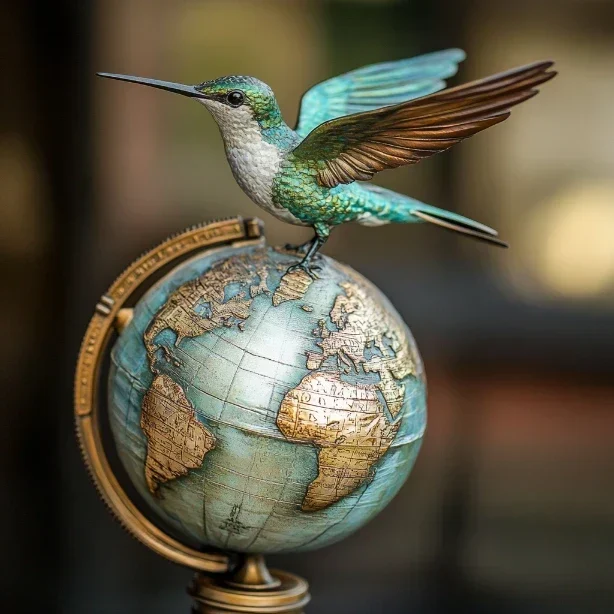(Or: Finding Nature’s Most Elusive Living Jewels)
In the world of hummingbirds, some species are like rare diamonds – precious, seldom seen, and found only in very specific locations. Although they might visit our gardens daily, their rarer cousins remain hidden in remote valleys, isolated mountaintops, and pristine forest fragments, each telling a unique story of evolution and survival.
Let’s begin with some statistics that make conservation biologists hold their breath:
- Fewer than 50 individuals of some species remain
- Several species known only from single mountain ranges
- Some spotted less than once per decade
- Many restricted to areas smaller than a city park
- Several potentially extinct in recent decades
The Colombian Treasures
Deep in the cloud forests of Colombia, some of the world’s rarest hummingbirds make their home. The country serves as both sanctuary and last refuge for several species teetering on the edge of existence. The Blue-bearded Helmetcrest, once thought extinct, clings to existence on remote páramo mountaintops, while the Colorful Puffleg decorates just a handful of mountain slopes with its presence.
Critical Colombian species include:
- Blue-bearded Helmetcrest
- Colorful Puffleg
- Gorgeted Puffleg
- Chestnut-bellied Hummingbird
- Each restricted to tiny habitat fragments
The Ecuadorian Enigmas
Ecuador’s dramatic landscape harbors some of the most endangered hummingbird species on Earth. In the country’s fragmented cloud forests, each valley might harbor its own unique species, evolved in isolation over millennia. The Black-breasted Puffleg, Quito’s official bird, survives only on the slopes of Pichincha Volcano, a living reminder of nature’s fragility.
Ecuadorian rarities include:
- Black-breasted Puffleg
- Violet-throated Metaltail
- Esmeraldas Woodstar
- Little Woodstar
- Each telling a story of specialized adaptation
The Peruvian Prizes
Peru’s varied landscapes harbor several rare hummingbird species, each adapted to specific ecological niches. From high Andean valleys to isolated forest patches, these specialized species represent unique evolutionary experiments in miniature.
Peruvian specialties include:
- Royal Sunangel
- Marvelous Spatuletail
- Purple-backed Sunbeam
- White-tipped Sicklebill
- Each demonstrates remarkable adaptation
The Brazilian Beauties
Brazil’s Atlantic Forest, though heavily fragmented, still harbors several rare species found nowhere else on Earth. These living jewels persist despite massive habitat loss, each population a precious reminder of the forest’s former glory.
Brazilian treasures include:
- Hooked-billed Hermit
- Minute Hermit
- Frilled Coquette
- Each restricted to specific forest fragments
The Caribbean Rarities
Island evolution has produced some of the world’s most distinctive and vulnerable species. Each Caribbean island harbors its own unique species, products of isolation and specialized adaptation.
Island endemics include:
- Bee Hummingbird of Cuba
- Jamaican Streamertail
- Puerto Rican Emerald
- Each evolved in splendid isolation
The Mexican Marvels
Mexico’s diverse landscapes harbor several rare hummingbird species, from mountain forests to desert oases. Each represents a unique adaptation to challenging environmental conditions.
Mexican specialties include:
- Short-crested Coquette
- Wine-throated Hummingbird
- Mexican Woodnymph
- Each facing unique conservation challenges
The Conservation Challenge
Protecting rare hummingbird species requires understanding their specific needs and the threats they face. Each species presents unique conservation challenges requiring tailored solutions.
Critical factors include:
- Habitat preservation
- Climate change impacts
- Local community involvement
- Research priorities
- Population monitoring
The Discovery Factor
Remarkably, new hummingbird species continue to be discovered, often in remote or unexplored regions. Each new discovery adds to our understanding of these remarkable birds.
Recent findings include:
- Range extensions
- New species descriptions
- Population rediscoveries
- Previously unknown behaviors
- Each expanding our knowledge
The Future Forecast
The fate of many rare hummingbird species hangs in the balance, dependent on conservation efforts and environmental protection.
Critical needs include:
- Protected area expansion
- Habitat restoration
- Population management
- Community engagement
- International cooperation
Conclusion: Guardians of Diversity
Each rare hummingbird species represents a unique chapter in Earth’s evolutionary story, a precious thread in the tapestry of life that, once lost, can never be replaced.
Remember: When we protect rare hummingbird species, we’re not just saving individual birds – we’re preserving millions of years of evolution and adaptation, each species a unique solution to the challenge of survival.
Post Script: Some researchers suspect there might be rare hummingbird species still unknown to science, hiding in remote valleys and unexplored forests. The birds maintain their characteristic elusiveness on this matter, but occasional surprising discoveries suggest they might be right.


